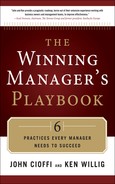Creating a planning process
So what do we mean by a planning process? Isn’t that just a confusing way of saying that we’re going to make a plan?
Here’s how we think of it: The planning process is an organized manner for obtaining interrelated information to create an effective plan. A key word here is “organized.” An effective planning process relies on an organized manner of collecting and analyzing all relevant information, and a good plan is the product of this effort.
We’re going to give you some guidance on building a planning process, but first we want to give you some examples. This will illustrate the value of a process clearly, before you get into the details of creating an actual process for your company.
If you were a home builder, the process of building a home would be much more valuable to you than the ability to build only one particular type of building. For example, if you only knew how to build one floor plan, you’d only be able to build houses that were all identical. And you’d probably be confused when a homeowner wanted to make changes to that floor plan. You’d take too long to figure out how to implement the changes, and the cost to you and to the customer would be too high. And you certainly wouldn’t be able to sell homes to people who didn’t like your one and only model.
Conversely, if you understood the process of homebuilding, you’d be able to make changes whenever required. And you’d do it efficiently. It would be cost-effective for the homeowner and profitable for you. You’d have great flexibility in your strategies. You’d be able to operate in a wide variety of neighborhoods, for numerous customers with widely varying preferences. You could build whatever the customer wanted, and you could do it quickly and profitably.
There are other examples all around us that illustrate the importance of a planning process. In many cases, the process is not only more important than any specific plan, it can mean the difference between success and failure. Or even life and death.
In a recent example of excellence in both emergency planning and airmanship, a commercial airliner in New York City survived a collision with a flock of large birds, shutting down the plane’s powerful engines. The pilots were now commanding a huge glider full of passengers, and they had no attractive options. But the pilots had been trained well. They quickly determined that they had two critical tasks to complete to ensure the safety of all on board.
First, they needed to find a place to put the airplane down—somewhere other than in the midst of the multi-story skyscrapers all around them. Because pilots are trained regularly to locate backup landing locations when emergencies arise, this activity was part of the planning process that the pilots had learned and practiced in their training sessions.
Second, they had to land the plane in such a way as to minimize damage. Here too, the airlines train their pilots on the proper means of bringing down an airplane when the engines fail. It’s not easy, but it can be done, and the pilots had practiced this repeatedly in elaborate and expensive simulators to hone their skills.
So, although the pilots likely had not practiced the specific situation they faced in New York, they had learned an effective process for planning. They knew how to assess the current situation, decide when alternative plans were required, and execute the precise maneuvers that had the best chance for the survival of everyone on board.
The pilots knew that they could not make it to any nearby airports; the plane was sinking too fast. But they saw a wide and relatively long flat surface that was within range and perhaps could substitute for a paved runway: the Hudson River. No one had ever filed a flight plan that included the phrase “and now land in the Hudson River,” but that is exactly what the pilots decided to do.
Next, the pilots knew that they had to bring the plane down on the surface of the river, and do so in a way that would minimize damage. News commentators referred to this maneuver as a “water landing,” which seems a bit contradictory, but why quibble?
The pilots knew that a water landing was a highly dangerous activity. The surface of the river would not behave as a concrete or asphalt runway, and the sudden drag of the plane in the water could quickly cause the plane to tilt, skid, or completely flip over.
But all that training in the process of planning paid off. Everyone walked, or swam, away safely.
There are other everyday examples where the planning process is more important that any specific plan. In football, the quarterback calls for a specific play when in the huddle, then assesses the field situation just before he runs his planned play, and then sometimes calls for a new plan just before the action starts. Military commanders perform similarly, calling for a change of tactics or strategy as new conditions unfold, thus abandoning the original plan. Even a good chef does the same, creating a different sauce or even an entirely new meal depending on the availability of ingredients or a mistake in the kitchen.
So, how do you do this in your business? How do you create a planning process, an organized manner for obtaining interrelated information to create an effective plan?
There are five fundamental steps for creating a planning process. Each of these steps is easy to understand; they just take some dedication to implement properly and regularly.
1. Identify the right information.
2. Engage everyone in collecting the information.
3. Create successful strategies.
4. Modify the strategies in light of new information.
5. Do this frequently.
